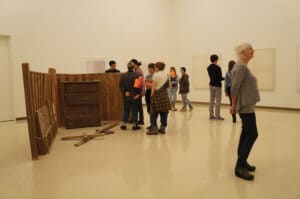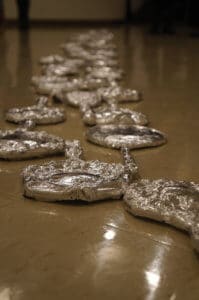Exhibit makes second stop in national tour, explores presence and place of objects in our lives
In co-curator Jay Wilson’s words, The Closer Together Things Are “is about nearness. It started with this idea of there being slight away-ness which is something, as a designer, [he’d] always thought was really interesting.” This exhibition at the Owens Art Gallery, which opened last Friday and will run until Feb. 21, is an exploration of everyday objects that are present in our lives, how they relate to each other and how they relate to us, their users and, ultimately, their destroyers. The show also depicts relationships between people and the ever-present distance between them. This concept was explained by co-curator Shannon Anderson as the “tension between knowing someone really intimately but then also being removed in some way.… You can never just become somebody else.” The exhibit, curated by Wilson and Anderson, featured work by Kathleen Hearn, Ève K. Tremblay, Laura Letinsky, Micah Lexier, Dave Dyment, Roula Partheniou, Rhonda Weppler, Trevor Mahovsky, Luke Painter and Chris Kline.

The exhibit navigates between figurative and direct depictions of these illustrations of space, creating a complex narrative out of seemingly mundane subjects. One of the pieces in the atrium is Roula Partheniou’s Twofold, a collection of everyday objects doubled and set at angle with each other. These, Anderson explained, demonstrate “very deliberately a mirroring that happens in the work. You see the same objects one way and the other … but it’s not until you spend the time studying [them] that you realize in what ways they’re different and what’s happening between one set of really simple objects and the next.” This is meant to be an entry point into the rest of the exhibit, as it illustrates in a very straightforward way the pairing and contrasting of objects which is present in many of the other work.

One of the pieces unique to this showing of the exhibit was two pages of the Sackville Tribune Post, pinned to the wall to draw attention to two advertisements showing Sam Rockwell in the film Moon. There are four sets of these ads, each one unique to the respective local newspapers of the four towns in which the exhibit is shown. Each ad is “specifically looking at doubles, doppelgangers or actors who have played themselves in a film of some kind.… It’s re-splitting something that was originally split and spliced together and separating it again just to underscore the artificiality of it and to emphasize the double-ness of it,” said Anderson. This concept was created by Micah Lexier and Dave Dyment.
Rhonda Weppler, another of the artists featured in the exhibit, was also present at the opening. Her collaborative work with Trevor Mahovsky is especially concerned with the notion of “trompe l’oeil.” One of their sculptures, The Visitation, showed a small, dilapidated room which was created from a single continuous surface of wooden veneer. Its back faced away from the doorway, hiding the fact that the sculpture, like most of Weppler and Mahovsky’s work, is hollow. Their other work in the exhibit, Music of Chance 4, displays hollow casts of found objects in aluminum foil. This piece is one in a series of ephemeral pieces made of aluminum foil that are designed to exist for the exhibition and then be recycled. At the Owens, the objects casted were antique hand mirrors, the type of objects that “fit into [a] family’s long history of material, and how it’s just that material and [a memory] connected to it,” explained Weppler. Her intention is to bring to light the temporariness of objects in our everyday life and “fast-forwarding that whole [process of destruction] because everything [she and Mahovsky] make is very fragile and only here momentarily.”
This exhibit takes the time to provoke questions about objects in our everyday lives which we often take for granted. As Anderson said, it brings to light “something kind of random and everyday but interesting and important in a lot of ways.”





